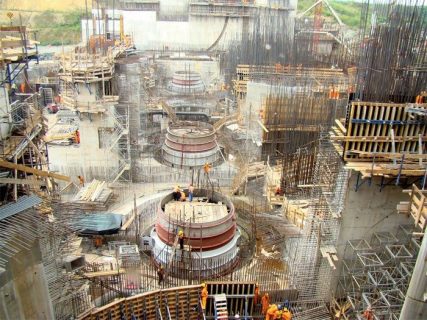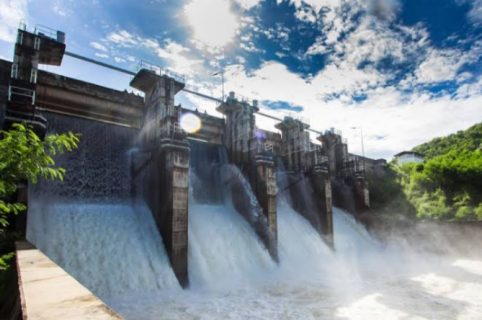O projeto da usina hidrelétrica de Karuma marcou recentemente a conclusão da primeira fase de suas unidades de energia.
According to the Sinohydro plant commercial manager, Mr. Kou Zhibin there have been enormous setbacks over time. These include the Covid-19 pandemic during which the contractor was forced to limit staff thus slagging on the construction progress. However, Zhibin said they have recorded substantial progress with 99% and 99.6% of the power station and transmission lines respectively complete.
Já o subgerente de projeto da UEGCL, Sr. Paul Tumwiine, disse que o projeto está em fase de testes a seco, o que significa a conclusão das obras de instalação.
Leia também: Últimos desenvolvimentos no projeto hidrelétrico Nyamwamba II em Kasese, Uganda
“These tests,” Tumwiine explained, “only require meeting standards of safety as they are internally recognized tests for power plants. They entail ensuring equipment is installed, which is 99 percent physical progress and 1 percent activity in achieving functionality.”
Ms. Wonekha commended Sinohydro Cooperation for the successful completion of the power project which is expected to start supplying half of its generation (300MW) next year. She said, “Many Ugandans have had great expectation for the presidential promise of more power. We yearn to see more of this as the facts and figures have shown,” she said.
O embaixador chinês, Sr. Zhang Lizhong, e o seu homólogo do Uganda, Sr. Oliver Wonekha, encomendaram o projecto, simbolizando a cooperação Uganda-China.
Visão geral do projeto da usina hidrelétrica de Karuma
Karuma hydroelectric power station project is being developed on the Nile River, in Kyandongo District, Uganda. Ministério de Energia e Desenvolvimento Mineral de Uganda (MEMD) e a Uganda Electricity Generation Company Limited (UEGCL) estão liderando o projeto de instalação de energia a fio d’água de 600 MW.
The project comprises the construction of a 20m-high and 312m-long roller compacted concrete (RCC) gravity dam that upon completion will be the largest of its kind in East Africa. It will have a 35km-long reservoir spread across an area of 2,737ha. The estimated gross reservoir volume is 79.87 million m³.
The Karuma hydroelectric power station project will also involve the construction of six 20m-high and 29m-wide water intake towers, six 7.7m diameter and up to 379m-long concrete lined pressure shafts. In addition, a 200m-long, 21.3m-wide, and 53m-high underground powerhouse cavern housing six 100MW vertical Francis turbines will be constructed. The turbines will operate under a gross head of 70m and a speed of 150 rotations per minute (rpm).
Leia também: Últimos desenvolvimentos no projeto hidrelétrico Nyamwamba II em Kasese, Uganda
Moreover, two 314m-long, 21.5m-wide, and 50m-high restricted orifice type tailrace surge chambers will also be built as part of the project. This is where water will be sent back to the river through two 12.9m diameter horseshoe-shaped tailrace tunnels approximately 8.6km long. The design discharge for the hydropower plant will be 1,128m³/s.
Power generated from the Karuma hydroelectric power station will be evacuated from an underground transformer cavern located just above the underground powerhouse. The 200m-long, 18.0m-wide, and 14.4m-high transformer cavern will be equipped with six 11kV/400kV step-up transformers and connected with the powerhouse through a 40m-long bus duct tunnel.
Three transmission lines will be used to feed the electricity generated by the facility to the national grid. These lines include the 248km-long 400kV Karuma-Kawanda line, the 55km-long Karuma-Olwiyo line, and the 80km-long Karuma-Lira transmission line. Furthermore, the project involves the construction of three new substations at Karuma, Kawanda, and Olwiyo. These will be built by the Empresa de Transmissão de Eletricidade de Uganda (UETCL).
O projecto da central hidroeléctrica de Karuma custará pelo menos 1.7 mil milhões de dólares. É financiado em 85% através de um empréstimo bonificado do Banco de Exportação-Importação (Exim) da China, while the Ugandan government provides the remaining 15%. The loan is set to be repaid over a period of 25 years, at an average interest rate of 3%.
Relatado anteriormente
1995
The Ugandan government first announced plans for the construction of a power station at Karuma Falls in 1995. Norpak, a Norwegian energy company was contracted to conduct the feasibility study and the environmental impact assessment (EIA) for the dam. The project was to be financed by the World Bank through a loan.
2006
Em outubro de 2006 foi divulgado o estudo de viabilidade do projeto. Em novembro do mesmo ano, o governo abriu licitação para a construção do empreendimento. O plano inicial era construir uma central eléctrica de 200-250 MW.
2009
The project plans were revised in 2009 to develop a much bigger dam of 750 MW. In the same year, Norpak withdrew from the project citing financial challenges due to the Global Recession of 2008-2012. Energia Infratech Private Limited foi contratada para realizar um novo estudo de viabilidade, bem como um EIA.
2011
In July 2011, the project’s capacity was scaled down to 600 MW. Some international development partners wanted to scale back even further, to a maximum capacity of 400 to 450 megawatts.
2013
Construction work at the power station officially started on 12 August 2013.
2015
Em março 2015, Alstom was sub-contracted by Sinohydro, the lead contractor on the project to supply equipment and technical services to the power station. Alstom was paid $65 million in the deal.
2016
As of March 2016, around 30% of the project had been completed. The project employed around 5,000 Ugandans and 1,000 Chinese.
Abril de 2016
Construção da barragem de Karuma no Uganda atingida pela escassez de cimento e mão-de-obra

Empreiteiros para o Barragem de Karuma em Uganda have complained of a shortage of the right quality of cement and workers that has adversely slowed their operations.
Num comunicado de imprensa aos jornalistas no fim de semana no local de construção, o oficial de ligação do projecto da central hidroeléctrica de Karuma, Sr. Qu Jinwei, disse que foram forçados a adquirir cimento de alta qualidade 42.5 do Quénia, uma vez que tanto Hima como Hima Fábricas de cimento Tororo não conseguiram fornecer as qualidades de que necessitam, pois estão habituados a produzir o cimento comum.
“We inspected their factories before we started the project and we noticed that they could not supply the qualities we wanted so we had to look elsewhere and we found Cimento Savanah no Quênia", Disse ele.
In response to the causes of the cracks in the dam, he said the cracks cannot be directly attributed to the cement used because they are negligible and they happen all the time in such types of projects. He said they would hold consultations with the parent company in China so as to rectify them. Mr. Jinwei said another major challenge encountered is the lack of qualified dumper truck drivers who can work in the tunnels where a lot of the operations take place.
“We have recruited many drivers who come on-site but when we take them to the highly restricted area where most of our operations are, many of them cannot maneuver the trucks through the tunnels,” he said.
Mr. Alok Kala, Tororo Cement’s chief marketing manager rubbished remarks over the quality o their cement saying the contractor has never bought their cement but they have been supplying to Isimba hydro dam.
Um dos motoristas, que falou sob condição de anonimato, rejeitou as afirmações de que os motoristas ugandeses não podem operar e gerir os camiões, dizendo que o salário é muito inferior à carga de trabalho.
This comes barely a few days after senior officials from the ministry of energy were suspended by President Museveni after it came to light that they did shoddy work at the Karuma and Isimba dams. Among those axed are Engineers Paul Mubiru, Henry Bidasala, and Cecilia Menya
2018
As of February 2018, 74% of the project had been done. In June of the same year, 76% of the work had been completed.
Abril de 2019
As of April 2019, around 80% of the project was complete. Three high voltage transmission lines were 80 to 85% complete at the time.
Maio de 2019
O projeto de energia de Karuma, em Uganda, será inaugurado em breve

Sinohidro Corporation Ltd, a empresa chinesa que está a realizar a construção da barragem Karuma de 600 MV no distrito de Kiryandongo, revelou que o projecto está 95% concluído. O projeto iniciado em 2013 deverá ser comissionado em dezembro de 2019.
Also Read:Malawi signs US $150m deal for Mpatamanga Hydroelectric project
Usina hidrelétrica de Karuma
The project, located in northwestern Uganda, has passed through great challenges before arriving at this completion stage. The construction company had to slow down the work after having noticed in 2016 the appearance of cracks on the dam, which the company explained was caused by climatic conditions of the area.
However, the issue was resolved and construction work progressed as planned. Upon completion, the Karuma hydroelectric power plant will be the largest in the African country, with a production capacity of 600 MW.
Setembro de 2019
Em setembro de 2019, o projeto estava 95% concluído, incluindo 100% de conclusão da Linha de Alta Tensão Karuma – Kawanda, 100% da Linha de Alta Tensão Karuma – Lira e 98% da Linha de Alta Tensão Karuma – Olwiyo.
novembro 2020
Construção da Usina Hidrelétrica Karuma em Uganda quase concluída

A construção da central hidroeléctrica de Karuma no Uganda está quase concluída, de acordo com Deng Changyi, gestor do projecto. O Sr. Changyi disse que a maior parte dos trabalhos físicos e de instalação estão concluídos e que faltam apenas 2 por cento de todo o trabalho. Isso inclui trabalhos como pintura, limpeza de túneis e construção de estradas na superfície.
O gerente do projeto disse que Sinohidro Corporation Ltd., o empreiteiro já solicitou aprovação para o comissionamento úmido das turbinas 1-3. Ele também revelou que estão em andamento os testes a seco das turbinas 4-6, cada uma projetada para produzir 100 MW.
Construção de linhas de evacuação de energia
A Sinohydro também é responsável pela implementação do Projeto de Interconexão Karuma, que facilitará a evacuação de energia da usina através de três linhas de transmissão.
Leia também: Uganda construirá o primeiro cabo submarino de energia do Lago Vitória
The overall work on the project according to Sinohydro’s progress report has reached 94.5 percent completion. Most of the tower erection and stringing works have been done, except for a few places where there has been a challenge in accessing the right of way.
O empreiteiro afirmou que Governo de Uganda é responsável pela aquisição do terreno e sua entrega para continuidade das obras.
